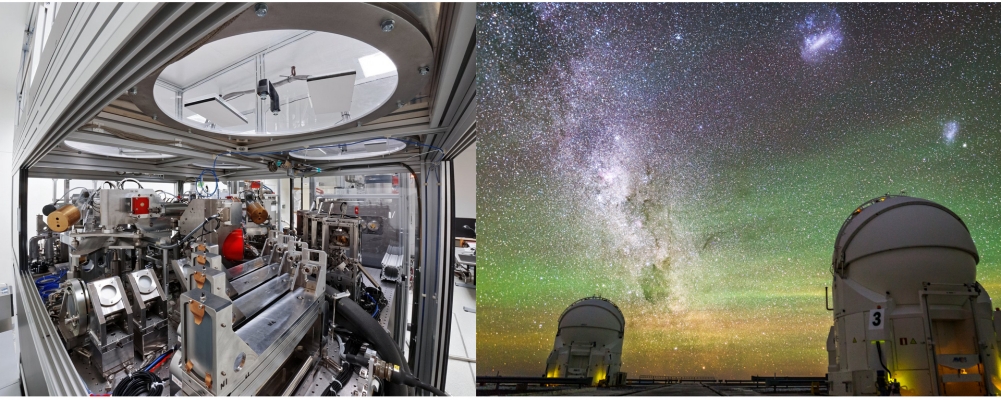MATISSE Science Verification with the Auxiliary Telescopes

Accepted Proposals
Prog. ID |
P.I. |
Title |
Priority |
status |
| 60.A-9271 | Stefan Kraus | Imaging self-gravitation effects in the fragmenting disk around a high-mass protostar | High | completed |
| 60.A-9272 | Markus Wittowski | Investigating mass loss from red supergiants: The stratification of molecular and dusty layers of AH Sco | High | completed |
| 60.A-9273 | Rebeca Garcia-Lopez | Inner and outer disk misalignments in transitonal disks: The case of the TTauri source HD143006 | High | completed |
| 60.A-9274 | Keichi Ohnaka | Imaging the clumpy outer atmosphere of the red supergiant Antares | Low | completed |
| 60.A-9275 | Jacques Kluska | Imaging a second generation protoplanetary disk | Low | partial |
| 60.A-9276 | Abigail Frost | Imaging the first transition disc around a massive protostar | Low | failed (too faint) |
MATISSE is the new mid-infrared 4T beam combiner of the Very Large Telescope Interferometer. When fully commissioned, it will cover simultaneously L, M and N bands (3-12 microns in wavelength) with various spectroscopic resolutions. It is described on these pages.
MATISSE will be offered for normal operations starting in Period 103 (April-September 2019). In the meantime, we wish to demonstrate MATISSE new capabilities during Science Verification: ability to perform synthetic imaging via a dedicated imaging run, as well as updated limiting magnitudes (comapred to P103). All astronomers are invited to participate in this unique opportunity. 10 nights with the ATs will be devoted to the MATISSE Science Verification (SV) starting on April 26 2019.
Limiting magnitudes for image reconstruction (typical 10% precision in visibility and few degrees in phase closure):
- L band coherent flux > 3 Jy for a 80 m baseline
- N band coherent flux > 20 Jy for a 80 m baseline
Limiting magnitudes for model fitting:
- L band coherent flux > 1 Jy
- N band coherent flux > 10 Jy
A call for SV proposals has been issued and the community is invited to submit proposals for the MATISSE SV using this proposal template and associated LaTeX file.
Imaging proposals should require observations with at least 2 of the 3 AT configurations Small, Medium and Large, with typically 6 calibrated observations per configuration. Execution of the observations will be optimized to fill the spatial frequency plane. The offered modes for SV are the same as for P103 (see this instrument page and the P103 MATISSE User manual).
The observations will be conducted in Service Mode by a dedicated team of ESO and MATISSE team astronomers and astronomers. The MATISSE SV team will be able to assist the successful PI¹s in the preparation and optimisation of the OBs on a best effort basis only. The collected data will be made available to the whole ESO user community.
GTO protected targets
The list of protected targets for the MATISSE Guaranteed Time Observations is available for P103. Observations of targets protected by the MATISSE GTO will not be accepted for SV.
WARNING: all (raw) data and calibrations are public immediately after the observations. There is no proprietary period nor earlier data release to the PIs. See the VLT Science Verification Policy and Procedures for more details.
Science Verification Team
- Xavier Haubois (ESO)
- Christian Hummel (ESO)
- Walter Jaffe (MATISSE)
- Bruno Lopez (MATISSE)
- Antoine Mérand (ESO)
- Anna Pala (ESO)
- Claudia Paladini (ESO)
- Isabelle Percheron (ESO)
- Romain Petrov (MATISSE)
- Thomas Rivinius (ESO)
- Markus Schoeller (ESO)
- Konrad Tristram (ESO)
- Markus Wittkowski (ESO)
Schedule
- 21st December 2018: Call for Proposals
- 21st January 2019: Deadline for proposal submission
- 22nd February 2019 : Proposers informed about the outcome
- 22nd March 2019: Deadline for Phase 2 Material for SV
- 26th April 2019: MATISSE Science Verification observations start
Pipeline
The MATISSE data reduction pipeline was released. Instructions for installing and running the pipeline can be found here:
http://www.eso.org/sci/software/pipelines/matisse/
Note this version is preliminary and has not been fully verified. If you notice unexpected behaviour, please consult the "Bug Reports" section of the page.
Citation Policy
Publications based on SV data obtained with the MATISSE instrument should quote the following reference paper: Lopez, B., et al., An Overview of the MATISSE Instrument - Science, Concept and Current Status, 2014, The Messenger, Vol. 157, pp. 5-12
General Information
An integral part of the commissioning of a new instrument at the VLT is the Science Verification phase. SV programmes include a set of typical scientific observations that should verify and demonstrate to the community the capabilities of the new instrument in the operational framework of the VLT Observatory. See the SV Policy and Procedures: http://www.eso.org/sci/activities/vltsv/svdoc.pdf
